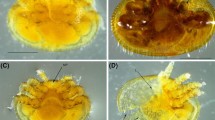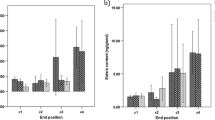Abstract
The roles of honey bee queen mandibular pheromone and colony congestion in the inhibition of swarming were investigated. Two colony siz.es were used: small, congested colonies and large, uncongested colonies. Both groups of colonies were treated with various dosages of the five-component, synthetic queen mandibular pheromone in the spring, and the extent and timing of swarming were followed. Most treatment groups received pheromone or a solvent blank (control) on a stationary slide; one group of the congested colonies received a pheromone treatment via an aerosol spray. The pheromone was not effective at delaying swarming in the congested colonies at any dosage applied on slides, but the aerosol spray-treated colonies swarmed significantly later in the season than the control colonies. The uncongested, pheromone-treated colonies exhibited a dose-dependent delay in swarming, with the highest dosage colonies swarming almost four weeks later than the control colonies. These results indicate an interaction between congestion and pheromone in the control of honey bee reproduction. While congestion may in itself be a factor stimulating swarming, these results are consistent with the interpretation that colony congestion reduces the transmission of queen pheromone within the nest, thereby removing the queen 's pheromone-based inhibition of queen rearing and subsequent swarming by workers.
Similar content being viewed by others
References
Butler, C. G. (1959). Queen substance.Bee World 40: 269–275.
Butler, C. G. (1960). The significance of queen substance in swarming and supersedure in honey bee (Apis mellifera L.) colonies.Proc. Roy. Entomol. Soc. Lond. A 35: 129–132.
Butler, C. G. (1961). The scent of queen honey bees (Apis mellifera) that causes partial inhibition of queen rearing.J. Insect Physiol. 7: 258–264.
Butler, C. G., and Callow, R. K. (1968). Pheromones of the honeybee (Apis mellifera L.): The “inhibitory scent” of the queen.Proc. Roy. Entomol. Soc. Land. A 43: 62–65.
Butler, C. G., and Paton, P. N. (1962). Inhibition of queen rearing by queen honey bees (Apis mellifera L.) of different ages.Proc. Roy. Entomol. Soc. Lond. A 37: 114–116.
Demuth, G. S. (1921). Swarm control.Farm. Bull. U.S. Dept. Agr. 1198: 1–28.
Gerstung, F. (1891).Der Bien und Seine Zucht, Pfenningstorff, Berlin.
Huber, F. (1792).New Observations on Bees, Vol. 1 (transl. 1926), Dadant, Hamilton, Ill.
Kaminski, L.-A., Slessor, K. N., Winston, M. L., Hay, N. W., and Borden, J. H. (1990). Honey bee response to queen mandibular pheromone in laboratory bioassays.J. Chem. Ecol. 16: 841–850.
Lensky, Y., and Siefert, H. (1980). The effect of volume, ventilation, and overheating of bee colonies on the construction of swarming queen cups and cells.Comp. Biochem. Physiol. 67a: 97–101.
Lensky, Y., and Slabezki, Y. (1981). The inhibiting effect of the queen bee (Apis mellifera L.) foot-print pheromone on the construction of swarming queen cups.J. Insect Physiol. 27: 313–323.
Morland, D. (1930). On the causes of swarming in the honeybee: An examination of the brood food theory.Ann. Appl. Biol. 17: 137–147.
Seeley, T. D. (1979). Queen substance dispersal by messenger workers in honeybee colonies.Behav. Ecol. Sociobiol. 5: 391–415.
Seeley, T. D. (1985).Honeybee Ecology, Princeton University Press, Princeton, N.J.
Simpson, J. (1957). The incidence of swarming among colonies of honey-bees in England.J. Agr. Sci. 49: 387–393.
Simpson, J. (1958). The factors which cause colonies ofApis mellifera to swarm.Insectes Soc. 5: 77–95.
Slessor, K. N., Kaminski, L.-A., King, G. G. S., Borden, J. H., and Winston, M. L. (1988). Semiochemical basis of the retinue response to queen honey bees.Nature 332: 354–356.
Slessor, K. N., Kaminski, L.-A., King, G. G. S., and Winston, M. L. (1990). Semiochemicals of the honey bee queen mandibular glands.J. Chem. Ecol. 16: 851–860.
Velthuis, H. H. W. (1970). Queen substances from the abdomen of the honey bee queen.Z. vergl. Physiol. 70: 210–222.
Willis, L. G., Winston, M. L., and Slessor, K. N. (1990). The effect of queen honey bee (Hymenoptera: Apidae) mandibular pheromone on worker ovary development.Can. Entomol. 122: 1093–1099.
Winston, M. L. (1987).The Biology of the Honey Bee, Harvard University Press, Cambridge, Mass.
Winston, M. L., and Taylor, O. R. (1980). Factors preceding queen rearing in the Africanized honeybee (Apis mellifera) in South America.Insectes Soc. 27: 289–304.
Winston, M. L. Taylor, O. R., and Otis, G. W. (1980). Swarming, colony growth patterns, and bee management.Am. Bee J. 120: 826–830.
Winston, M. L., Slessor, K. N., Willis, L. G., Naumann, K., Higo, H. A., Wyborn, M. H., and Kaminski, L.-A. (1989). The influence of queen mandibular pheromones on worker attraction to swarm clusters and inhibition of queen rearing in the honey bee (Apis mellifera L.).Insectes Soc. 36: 15–27.
Winston, M. L., Higo, H. A., and Slessor, K. N. (1990). The effect of various dosages of queen mandibular pheromone on the inhibition of queen rearing in the honey bee (Hymenoptera: Apidae).Ann. Entomol. Soc. Am. 83: 234–238.
Author information
Authors and Affiliations
Rights and permissions
About this article
Cite this article
Winston, M.L., Higo, H.A., Colley, S.J. et al. The role of queen mandibular pheromone and colony congestion in honey bee (Apis mellifera L.) reproductive swarming (Hymenoptera: Apidae). J Insect Behav 4, 649–660 (1991). https://doi.org/10.1007/BF01048076
Issue Date:
DOI: https://doi.org/10.1007/BF01048076




